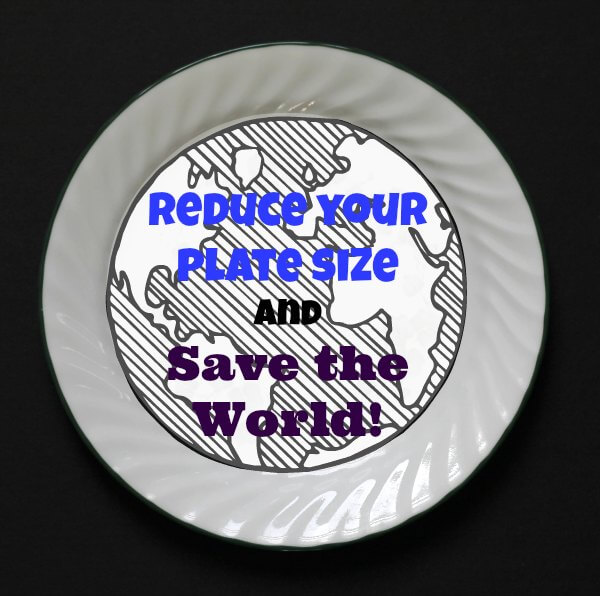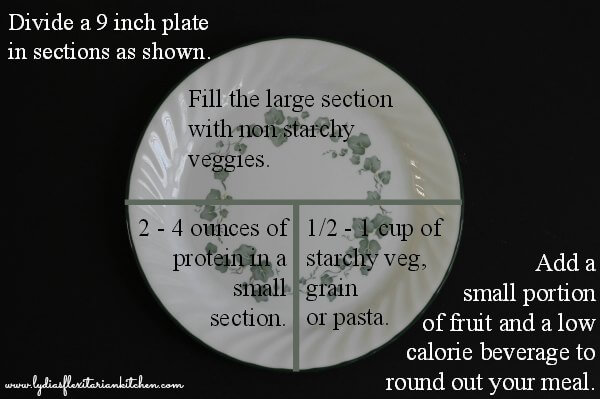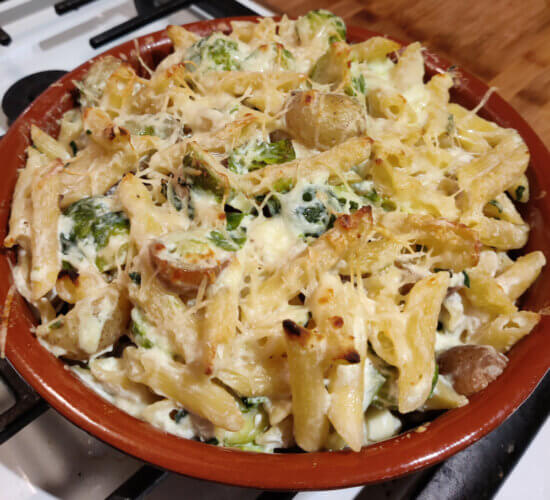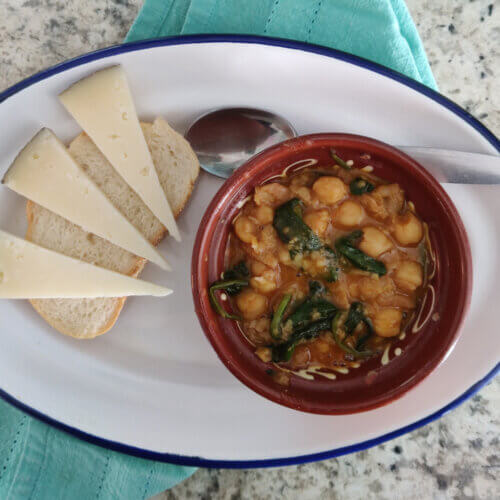Easter has long been my favorite holiday. I love the contemplative nature of Lent and the time spent with family and friends without the rush and sense of obligation that seems to accompany the Christmas holidays. Easter brings this year’s Carbon Fast to a close. You may recall we’ve been recycling and reusing our food packaging and food waste in order to reduce the amount of waste coming from our home. Today, I’d like to wind up the Carbon Fast by talking about another type of reduction that could potentially have a very large impact and not just on our waistlines.

Large portions are a marketing gimmick. We don’t need to eat as much as we do, but our appetites are appealed to with larger portions. We perceive larger portions as a greater value and since they are marketed to us, we have come to see them as normal. Consider these two campaigns from the 1980’s:
That 32 ounce Big Gulp Coke has 91 grams of sugar in it (Source)! 91 grams divided by 28 grams/ounce equals 3.25 ounces of sugar!
How about these dear ladies, wondering why the burger doesn’t fit the bun?
In the 1950’s a burger AND the bun and pickle weighed about 4 ounces. Nowadays a half pound burger is common place (and that’s not including the bun).
There’s no denying portions are larger and our plates have increased in size in order to accommodate them. In the 1960s the average plate size was 9 inches. Today it’s not unusual to see 11 or 12 inch plates. Coffee mugs and cereal bowls have gotten bigger, too. The increase in plate size can account for greater than 20% increase in intake! (Source One and Source Two)
You know what else has gotten larger? The number of prescriptions written to relieve the gastric distress caused by over eating. (Source). In addition, as waistlines and portions have expanded, the number of new diabetes diagnoses rose 128%! (Source)
The American Diabetic Association recommends using a 9 inch plate for meals and offers a common sense way to fill them. Visually divide your plate in half, then in half again to make three sections. Fill the largest section with non starchy vegetables. One of the small sections should hold a serving of protein. The final section is for starchy vegetables, grains, bread or pasta. Add a small piece of fruit and a low calorie beverage to round out your meal.

This arrangement will work for most meals. Naturally you’d make adjustments for a pasta or casserole dish. One serving of spaghetti is 2 ounces dry weight, about 3/4 cup when cooked, depending on the shape. For grains use a one ounce dry measure or about 1/2 cup cooked. Again, adjust if eating a casserole, about 1 1/2 to 2 cups.
The smaller plate automatically helps limit the amount you can put on a plate, but for those who can’t stand to be imprecise, the ADA sells a tool they call a Meal Measure which can act as a guide. I’m planning to talk more about portions in future posts.
It’s probably easy to see how this will reduce your waistline, but how about saving the world? The answer lies in the serving size. To use burgers as an example, if we use a 2.5 ounce portion instead of a 4 ounce patty, we increase the servings per pound from 4 to 6.4. For every 100 pounds of burger (1600 ounces) 240 more servings are created. While not all the meat from a cow is turned into patties, if it was, reducing the portion size means about 1200 more servings per 500 pounds of sale-able meat.
Reducing the amount of sugar consumed via soft drinks or added to processed foods, will not only help trim your waist, you’ll help reduce your risk of heart disease (Source). In addition, consuming less sugar translates into fewer truckloads of product which means more fuel for other purposes. To further drive the point home, let’s consider my town which has a population of about 31,000 people. Cutting the sugar consumption in half to 75 pounds per person a year means a savings of about one tractor trailer load of sugar a week. Extrapolate that figure over the population of the United States and we’re talking over 10, 000 truckloads per week! [313.9 million people times 75 pounds of sugar saved divided by 45000 pounds per truckload divided by 52 weeks].
I have to admit these numbers blow me away and I feel my estimates are conservative because I used general information instead of digging into industrial reports. Obviously, I haven’t addressed the huge amounts of water and fuel used in agriculture. I’m only scratching the surface at the energy used to process and transport our food. Nor have I talked about the costs arising from diseases associated with overeating.
Portion control will help you reduce the number of calories consumed, perhaps impacting your health as well as your weight. It will stretch your food dollars by increasing the number of portions served per pound. Your efforts will help save the world by reducing the resources needed to bring adequate amounts of food to the table. Be a hero!







Usually I do not read post on blogs, but I would like
to say that this write-up very forced me to check out and
do so! Your writing taste has been surprised me.
Thank you, quite nice article.
Also visit my blog: Bee Swarm Removal Westonaria
I was a kid in the 50’s and the focus was not on food or “getting things” like it is now…. it is way ramped up now. This was a wonderful post.
Thank you. We had the same experience growing up. I’m not sure when it changed, but for me I remember being aware of tie ins with toys/movies/food with the Star Wars franchise in the late 70s.
i try and reduce my plate size or pile on the veggies. but i think the rest of me needs to get on board with that b/c my stomach knows i’m not fooling it!
thanks so much for your visit and comment on my paris trip! yay, rick steve’s all around, i’ve used his books in spain and holland, too.
Thanks so much for stopping by and linking up to The Yuck Stops Here! We have changed the day we go live. Starting this week you can link up with us starting on Tuesday @ 6:00 pm EST. Hope to see you there!
Great information Lydia. People in the US definitely do eat too much and the wrong foods on top of that. I will share this on google & pinterest. Have a healthy happy day!
Thanks, Marla! Hope you have a great week 🙂
I need to reduce my plate size to lose some weight! Loved the picture of the plate up above. I hope you are able to sell some bundles today! Thanks for linking up with the Bloggers Brags Pinterest Party. I have pinned your post to the Bloggers Brags Pinterest Board!
Thanks Tammy! Best wishes to you, too.
I wish restaurants would do the same… I am always floored when I get a meal with enough food on the plate to feed my family of four and I am NOT exaggerating. Thank you so much for sharing this with us and your recipes on foodie friday.
I know what you mean. Rick and I will often share a plate.
How fascinating to learn that plates have gotten bigger in the last few decades! I have been wanting a set of Corelle plates so that my kids can handle doing dishes more easily. And now you’ve given me another great reason!
I live in an older home and a few years ago I had a set of dishes that were so big the door to the cupboard couldn’t close all the way. I replaced them with Corelle, too. I was happy to get rid of those big heavy things. Thanks for stopping by and taking the time to comment.
Such great info! I loved your title 🙂 and look forward to your upcoming post on weight loss ~
Thanks for linking up at Twirl and Take a Bow!
What an interesting post! It is amazing how the food world has changed so much in the US over the years!
This is such a fantastic post!
Thanks for joining the Link Up this week!
Wow – that is some crazy information that I never really thought about. Thank you so much for this “food for thought”!
You’re welcome! My original intent was to write from a weight loss perspective, but the research led me in another direction. I plan to address portion control for weight loss in another post. Thanks for dropping by!